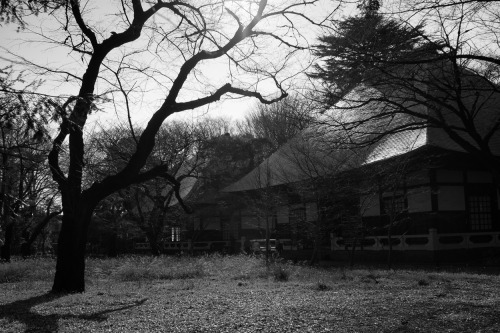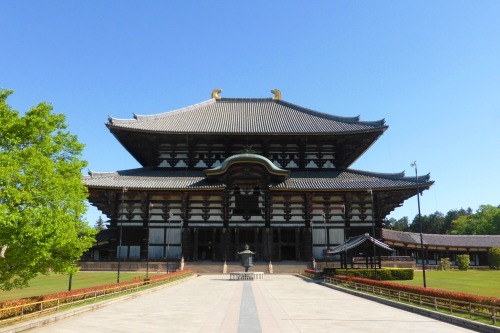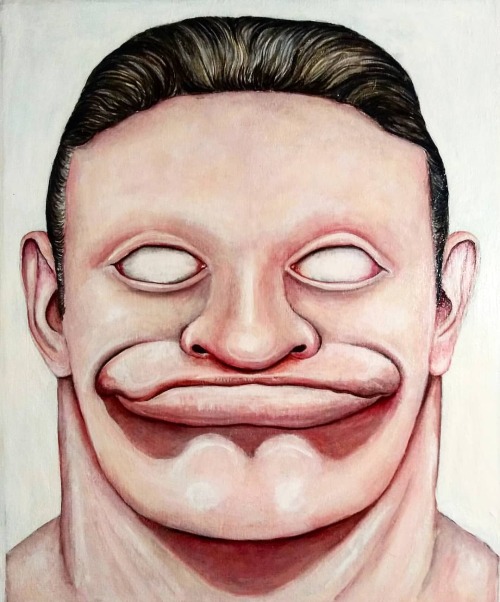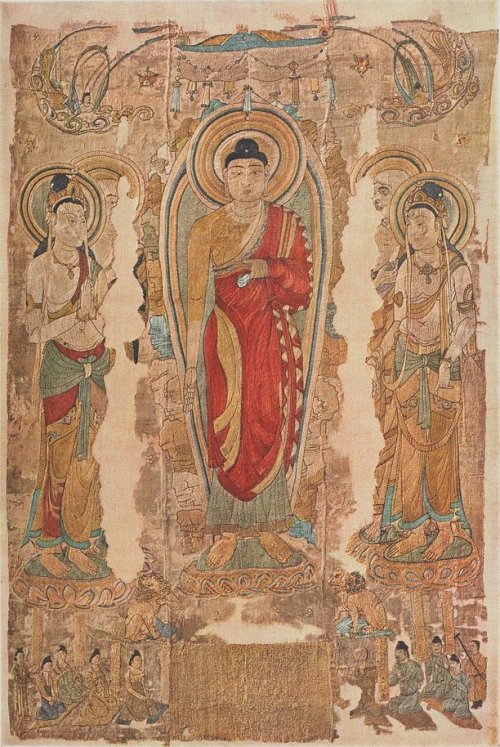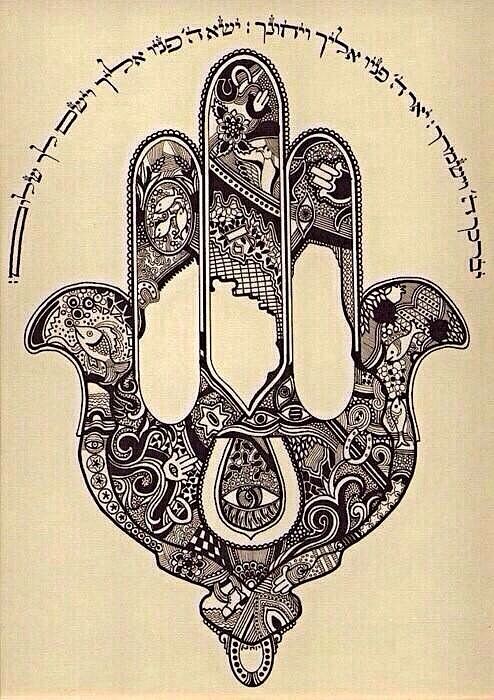#buddhism
When one goes to Obaku temple in Kyoto he sees carved over the gate the words “The First Principle”. The letters are unusually large, and those who appreciate calligraphy always admire them as being a mastepiece. They were drawn by Kosen two hundred years ago.
When the master drew them he did so on paper, from which the workmen made the large carving in wood. As Kosen sketched the letters a bold pupil was with him who had made several gallons of ink for the calligraphy and who never failed to criticise his master’s work.
“That is not good,” he told Kosen after his first effort.
“How is this one?”
“Poor. Worse than before,” pronounced the pupil.
Kosen patiently wrote one sheet after another until eighty-four First Principles had accumulated, still without the approval of the pupil.
Then when the young man stepped outside for a few moments, Kosen thought: “Now this is my chance to escape his keen eye,” and he wrote hurriedly, with a mind free from distraction: “The First Principle.”
“A masterpiece,” pronounced the pupil.
Provided he makes and wins an argument about Buddhism with those who live there, any wondering monk can remain in a Zen temple. If he is defeated, he has to move on.
In a temple in the northern part of Japan two brother monks were dwelling together. The elder one was learned, but the younger one was stupid and had but one eye.
A wandering monk came and asked for lodging, properly challenging them to a debate about the sublime teachings. The elder brother, tired that day from much studying, told the younger one to take his place. “Go and request the dialogue in silence,” he cautioned.
So the young monk and the stranger went to the shrine and sat down.
Shortly afterwards the traveler rose and went in to the elder brother and said: "Your young brother is a wonderful fellow. He defeated me.“
"Relate the dialogue to me,” said the elder one.
“Well,” explained the traveler, “first I held up one finger, representing Buddha, the enlightened one. So he held up two fingers, signifying Buddha and his teaching. I held up three fingers, representing Buddha, his teaching, and his followers, living the harmonious life. Then he shook his clenched fist in my face, indicating that all three come from one realization. Thus he won and so I have no right to remain here.” With this, the traveler left.
“Where is that fellow?” asked the younger one, running in to his elder brother.
“I understand you won the debate.”
“Won nothing. I’m going to beat him up.”
“Tell me the subject of the debate,” asked the elder one.
“Why, the minute he saw me he held up one finger, insulting me by insinuating that I have only one eye. Since he was a stranger I thought I would be polite to him, so I held up two fingers, congratulating him that he has two eyes. Then the impolite wretch held up three fingers, suggesting that between us we only have three eyes. So I got mad and started to punch him, but he ran out and that ended it!”

“n – a Buddist guardian of children and travellers or statues of him. Usually in the form of じぞうさま. These statues are found in temples and all over Japan at roadside or on paths.” – Oxford Japanese Minidictoinary, © Jonathan Bunt 2000, 2001, pg 103.

The Jizo / Ojizousama is one of Japans most loved Japanese divinities, as he is affiliated with protection and the saving of “lost” souls. More commonly the souls of children who have passed before ‘their time’. It is said that Ojizousama helps babies, still borns and children’s souls to pass onto the afterlife, saving them from an eternity of piling stones on the banks of the Sanzu River (a river which is believed to have to be crossed in order to reach the afterlife). In doing so he hides the young souls in his cloak, protecting them from demons and carrying them across.
It is quite common to find these statues in cemeteries, temples and on roadsides/paths and sometimes accompanied with little stones, pebbles and/or coins. These little offerings are given as thanks for saving/protecting someone or in hopes that this divinity with aid someone lost.
Ojizousama is also believed to be the protector of travellers, or dousojin, and Firefighters.

I did the cover of this book, which finally hit the shops. But it’s in Dutch. Sorry: Waarom de Boeddha zo van lijstjes hield-Why The Buddha Liked Lists.
Lees hier een interview met de schrijver (en mij) over de ontstaansgeschiedenis van het boek
“If the Buddha and the Christ were to meet today what do they have to tell each other? Not only do they meet today but they met yesterday, they met last night, they are always in me and they are very peaceful and united with each other. There is no conflict at all between the Buddha and the Christ in me. They are real brothers, they are real sisters within me. This is part of the answer.”
Thich Nhat Hanh
“The cosmos is filled with precious gems. I want to offer a handful of them to you this morning. Each moment you are alive is a gem, shining through and containing earth and sky, water and clouds. It needs you to breathe gently for the miracles to be displayed.
Suddenly you hear the birds singing, the pines chanting, see the flowers blooming, the blue sky, the white clouds, the smile and the marvelous look of your beloved.
You, the richest person on Earth, who have been going around begging for a living, stop being the destitute child. Come back and claim your heritage. We should enjoy our happiness and offer it to everyone. Cherish this very moment. Let go of the stream of distress and embrace life fully in your arms.”
Thich Nhat Hanh
If you’re so swag then how come you don’t have the keys to äloüsommen: the frozen Buddhist Norwegian temple hidden under a fjord??
If you’re so swag, open the door for us
This is a fabulous koan
“Occult literature and teachers of the Lesser Mysteries often terrify the audiences with the horrors of the abyss, the void.
They talk of extinction and nonexistence.
And it is true that the abyss terrifies those who are still attached to individuality.
That is why it is the true function of the Mysteries is to prepare the mind for the plunge into the Divine Depths.”
Post link
EMPTINESS = HAPPINESS
acrylic on canvas 24 x 30cm
#contemporarypainting #collageart #portrait #buddhism #belgianpainting #belgianart #galleryart #instagramartist #paintingsofinstagram
https://www.instagram.com/p/CNBk1AwlL2n/?igshid=letwic4sycjt
Post link
engrave traditional chinese seals
Embroidery picture of Śākyamuni on the Vulture Peak / Book from Marc Aurel Stein, The thousand Buddhas.
Post link
I’ll say it before and I’ll say it again
CHAKRA’S ARE A BUDDHIST PRACTICE AND THEREFORE NOT PART OF A CLOSED RELIGION
A little louder for the people in the back
Chackra’s are a Buddhist practice and therefore not part of a closed religion
Interesting, I had always thought they were closed because they are also a part of Hindu belief. But after looking through the comments and then looking into it a little bit online, I see that there is a chakra system in both Buddhism and Hinduism.
It seems that Buddhists believe in a five chakra system, while Hindus believe in six of seven. So (genuine question!) does this mean that to work with the five chakra system would be acceptable but to work with the six or seven system would be appropriative?
Fantastic question!
Six chakras is pretty much an exclusive Hindu belief, but once you go into a deeper level of chakra study, then there is no defined system. However, for the average beginner, Buddhism usually believes in 4,5,7, or 10 chakras, depending on the person. 5 was the first system introduced to Buddhism and is still the main system used by , 4 is less common, 7 is the newest but also the most common, and 10 is the least common. However they are all studied and practiced for the last 450+ years so take that as you will.
Here’s what I’ve always studied and what I’ve always taught. Chakras are a gathering of energy that are attached to us but exist in an extraordinarily fluid reality. Each person is going to have more or less depending on themselves, and what they hope to accomplish when they are focusing on their chakras. However most people have one at their head, one at their heart, and one at the end of the spine known. But Chakras aren’t fixed at these locations. There are some people I know who focus on as many as 16 chakra points. However for the average student, 5 or 7 is the way to go.


